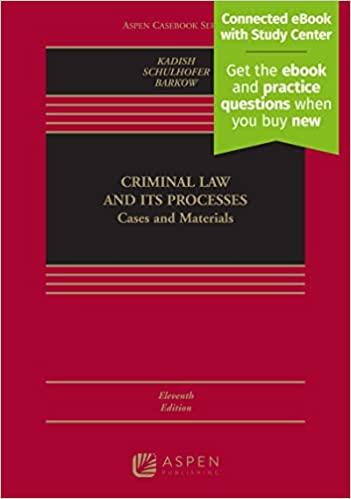Answered step by step
Verified Expert Solution
Question
1 Approved Answer
Mapp v. Ohio, 367 U.S. 643 (1961) Instructions : A case brief is short summary of a legal opinion. It contains a written summary of
Mapp v. Ohio, 367 U.S. 643 (1961) Instructions: A case brief is short summary of a legal opinion. It contains a written summary of the basic components of that decision. It is a method of studying case law. It helps students identify the key points of a legal opinion. Most case briefs contain similar information, but the headings and their sequence may be different. For this assignment you are required to follow the general format as set forth below:
- Case Name: Include the full citation and including the date of the opinion. The citation of the case is usually next to the case name in the legal opinion.
- Procedural History: The procedural history is the disposition of the case in the lower court(s) that explains how the case got to the court whose opinion you are reading. The procedural history must include: (1) The lower court who heard the decision; and (2) Who appealed that decision.
- Statement of Facts: Include only the facts that were relevant to the court' decision. You are unlikely to know what these are until you have read the entire opinion. Many cases may include procedural facts that are relevant to the decision in addition to the facts that happened before litigation.
- Issue: The question the court had to decide in this case. It usually includes specific facts as well as a legal question. It may be expressed or implied in the decision. Cases may have more than one issue.
- Holding/Decision: The legal answer to the issue. If the issue is clearly written, then the holding can be expressed a "yes" or "no."
- Rule of Law: The general legal principles relevant to the factual situation presented in the case.
- Reasoning: The logical steps the court takes to arrive at the holding. This is the court's analysis of the issues and the heart of the case brief. It can be straightforward and obvious, or you may have to extrapolate it from the holding. The reasoning states why the court made that decision. It should be the longest section in the brief.
- Judgment/Disposition: The judgment is the court's final decision as to the rights of the parties, the court's response to a party's request or relief. Generally, the appellate court will either affirm, reverse, or reverse with instructions. The judgment is usually found at the end of the opinion.
Step by Step Solution
There are 3 Steps involved in it
Step: 1

Get Instant Access to Expert-Tailored Solutions
See step-by-step solutions with expert insights and AI powered tools for academic success
Step: 2

Step: 3

Ace Your Homework with AI
Get the answers you need in no time with our AI-driven, step-by-step assistance
Get Started


